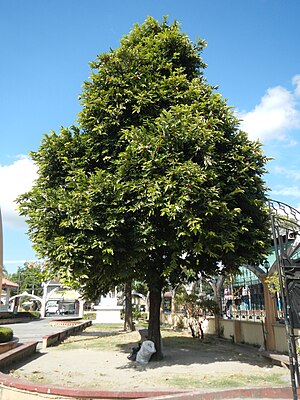Diospyros discolor
| Diospyros discolor | ||||||||||||
|---|---|---|---|---|---|---|---|---|---|---|---|---|

Diospyros discolor |
||||||||||||
| Systematics | ||||||||||||
|
||||||||||||
| Scientific name | ||||||||||||
| Diospyros discolor | ||||||||||||
| Willd. |
Diospyros discolor (Syn .: Diospyros blancoi A.DC. ) is a plant of the genus Diospyros ( Diospyros ) within the family of the ebenaceae (Ebenaceae). This tropical crop is called mabolo in the Philippines.
description
Vegetative characteristics
Diospyros discolor is an evergreen tree that reaches heights of growth of up to 33 meters and a trunk diameter of up to 80 centimeters. Diospyros discolor grows slowly and there are roots . The more or less rough to slightly cracked bark is brownish to gray-brown.
The alternately arranged, entire, short-stalked leaves are leathery, dark green, glabrous on top and fine, whitish hairy on the underside. They are egg-shaped to elliptical, elongated or ovate-lanceolate to obovate, -eilanceolate. The leaves are about 15-22 inches long and at the tip they are pointed or acuminate. The young leaves are partly salmon red.
Generative characteristics
Diospyros discolor is dioecious separately-sexed diocese . The radial symmetry , mostly four-fold flowers have a double flower envelope . The almost sessile flowers are yellowish-creamy white to slightly reddish. The sepals are fine-haired on the outside. The male flowers have many stamens and the female some staminodes. The ovary is on top.
Roundish and orange-red, finely hairy, fine-furry fruits, berries , with a yellowish, floury-fibrous pulp are formed. The remains of the sepals are often still preserved. They are about 5–10 centimeters tall and thin-skinned, they often appear to have grown together in pairs. The up to about 4-8 brown, relatively smooth, elliptical, slightly flattened seeds are up to about 4 centimeters long.
use
Mabolo is widely grown in the Philippines . As a useful plant it is widespread in large parts of the tropics, but nowhere except in Southeast Asia.
The peel of the Mabolo berry gives off an unpleasant, cheesy odor, which can be reduced by keeping the berry in the refrigerator for a few hours or peeling it before consumption. The fruit can be used raw as edible fruit, in fruit salads or canned in syrup; with the latter, however, the pulp becomes fibrous and tough. The furry skin should be removed when eaten raw, it is quite unpleasant in the mouth. The berry is considered a good source of iron, calcium, and B vitamins. They should be stored for a few days before consumption so that they are fully ripe and soft.
distribution
Diospyros discolor occurs in eastern and southern Taiwan , the Philippines , and eastern Borneo .
Taxonomy
The first description under the name Diospyros discolor was made by Carl Ludwig Willdenow . Synonyms of Diospyros discolor Willd. are: Embryopteris discolor (Willd.) G. Don nom. superflat., Diospyros mabolo Roxb. ex JVThomps. nom. superflat., Diospyros philippensis (Desr.) Gürke nom. illeg., Cavanillea mabolo Poir. , Diospyros mabolo (Poir.) Roxb. ex Lindl. nom. illeg., Mabola edulis Raf. , Diospyros blancoi A.DC. , Diospyros malacapai A.DC. , Diospyros utilis Hemsl. , Diospyros merrillii Elmer , Diospyros durionoides Bakh.
swell
Individual evidence
- ↑ a b Rafaël Govaerts (Ed.): Diospyros discolor. In: World Checklist of Selected Plant Families (WCSP) - The Board of Trustees of the Royal Botanic Gardens, Kew . Retrieved October 17, 2017.
literature
- Julia F. Morton: Fruits of Warm Climates. Miami, 1987, ISBN 0-9610184-1-0 , pp. 418-419.
- Mabolo at Hort Purdue.
Web links
- as Diospyros blancoi on Useful Tropical Plants ,.


